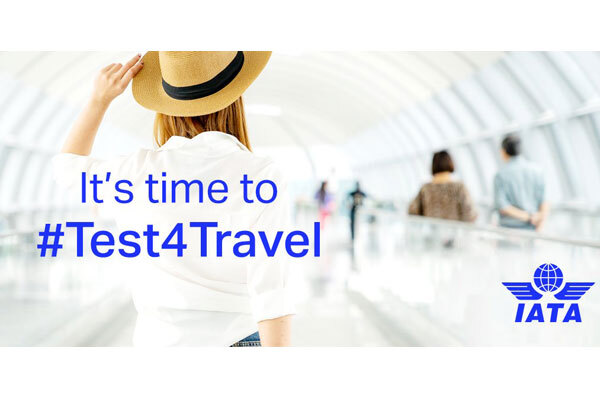The International Air Transport Association (IATA) welcomes the publication of the Manual on Testing and Cross Border Risk Management Measures by the International Civil Aviation Organization (ICAO). This document provides governments a risk-based assessment tool for using testing programs that could alleviate quarantine requirements.
It is a critical output produced by the ICAO Collaborative Arrangement for the Prevention and Management of Public Health Events in Civil Aviation (CAPSCA). CAPSCA brings together the expertise of states, public health authorities (World Health Organization/WHO, Centers for Disease Control and Prevention, European Centre for Disease Prevention and Control) and industry experts (IATA, Airports Council International, International Coordinating Council of Aerospace Industries Associations).
This encouraging progress follows recent comments from the WHO’s International Health Regulations Emergency Committee Chair, Dr. Didier Houssin, who foresees a role for testing as a means of re-opening international travel without quarantine measures. Following the WHO Emergency Committee meeting on 30 October 2020, he said that, “clearly the use of the tests is certainly now supposed to have a much larger place compared to quarantine, for example, which would certainly facilitate things considering all the efforts which have been made by airlines and by airports.”
“Momentum is building in support of our call for systematic testing to safely re-open borders without quarantine measures. ICAO, working with health authorities and industry, has produced a high-level framework. Health authorities are beginning to explore how testing could supersede quarantine to stop the cross-border spread of the virus. Encouraging results from testing pilot programs should now give states the confidence to move forward quickly,” said Alexandre de Juniac, IATA’s Director General and CEO.
Testing—Efficacy and Performance
Pilot programs for COVID-19 testing of travelers are beginning to produce encouraging results proving their efficacy.
- A study on arriving passengers in Toronto tested passengers three times: on arrival, at day 7 and at day 14. One percent of passengers tested positive over that period, with 70% being detected with the first test. In other words, the study’s results could indicate the potential for about 60 out of every 20,000 travelers to go undetected on arrival, which is significantly lower than the underlying prevalence in Canada.
- A pre-departure testing program for the Milan/Linate-Rome/Fiumicino route detected about 0.8% of passengers with COVID-19. As this level of incidence is considerably higher than the reported prevalence of COVID-19 in Italy at the time, it would appear that not only was testing highly effective in identifying infected travelers but that systematic testing is the best way to detect asymptomatic cases and to break chains of transmission.
- A soon to be published European study is even more optimistic. It models scenarios for a highly effective testing mechanism. In a low prevalence scenario, there is the potential to see the number of undetected positive cases as few as 5 per 20,000 travelers, increasing to 25 in high prevalence situations. These levels of incidence are still much lower than the underlying prevalence of COVID-19 in Europe.
- IATA modeled the testing results to quantify the risk that would remain if systematic pre-departure testing were implemented. Assuming that testing identifies 75% of travelers correctly who have COVID-19 (the effectiveness of the test) from a source population with a prevalence of 0.8% of the population (e.g., similar to Chile), the risk is that 0.06% of passengers would have the disease and go undetected. That would mean 12 undetected positive cases for every 20,000 arriving passengers.
These studies all point in the direction of testing being an efficient means to limit the spread of COVID-19 through air travel. “Data show that systematic testing can reduce the risk of importing COVID-19 through travel to very low levels – not zero, but very low. Certainly in most cases it would reduce risk to levels that mean that arriving passengers are less likely to be infected than the local population and therefore do not add meaningfully to the prevalence of COVID-19 in most places. Efficiency will increase. Advances in technology are happening every day that will improve testing performance,” said de Juniac.
IATA encourages speed and a focus on risk management. “Our mindset must be focused on managing the risks of the virus while maintaining the overall well-being of the population. That would be a shift from current government policies entirely focused on risk elimination until a vaccine is available and at any cost to people’s lives and livelihoods. Even with recent encouraging news, it will be well into 2021 before we can expect large scale vaccination. In the meantime, denying people the freedom of mobility will do irreparable damage to jobs and our way of life. Strategies with risk-based testing offer a pathway which can safely facilitate an economic revival benefitting from the rewards of a re-connected world. Governments could further reduce the risk by investing in effective contact tracing and health monitoring programs to quickly isolate any potential community transmission. And there could even be benefits to controlling the disease by large scale testing of travelers who are not displaying symptoms,” said de Juniac.
Significant advances in testing technology will help governments implement testing for travelers without compromising the availability of tests directly related to the healthcare sector, particularly polymerase chain reaction (PCR) testing. For testing to be incorporated into the travel process it must be fast, accurate, scalable, easy to use and affordable. While IATA does not recommend a specific test type, laboratory reported accuracy for the rapid antigen test (RAT) does meet the aforementioned criteria. The Oxford/Public Health England study indicates 99.6% specificity along with very high sensitivity for RAT.
Practicalities
Testing is supported by travelers. An IATA survey revealed that 83% of people would not travel if it required quarantine. It also showed that some 88% of travelers would be willing to be tested if it enabled travel. The same survey also revealed that 65% believe that quarantine should not be necessary if someone tests negative for COVID-19. “Public opinion supports COVID-19 testing. They see it as a far better option compared to quarantine which kills travel. And they feel comfortable that if you are tested and found negative you don’t need to quarantine,” said de Juniac.
Global standards are needed to transform the many testing pilots and “bubbles” into a global re-start of international flying. To support this IATA is developing:
- A practical implementation guide for the Manual on Testing and Cross Border Risk Management Measures
- The IATA Travel Pass to manage COVID-19 test certifications, one of several solutions in development to help manage testing certifications. IATA welcomes the evolution of a competitive market for these solutions that should be cost-effective, global, accurate and interoperable.
Speed
IATA urges quick action by governments working with industry to implement a globally harmonized and systematic approach to COVID-19 testing in the travel process.
Travel essentially remains in lockdown. Each day that this situation is prolonged puts more jobs at risk and makes the road to recovery that much more difficult.
Implementation of a globally harmonized systematic testing regime for international travel would complement measures already well established to keep travelers safe. In June, ICAO published Take-off: Guidance for Air Travel through the COVID-19 Public Health Crisis which calls on governments to implement a multi-layered approach to sanitary measures throughout the travel process. Mask-wearing is especially key to the Take-off requirements with a strong consensus among recently published studies of air travel and COVID-19 pointing toward the very low risk of inflight transmission (Harvard, TRANSCOM).
“Safety is at the core of aviation. This crisis has only reinforced that commitment. There has been an inspiring effort by governments, public health authorities and aviation entities to ensure safe operations even during this pandemic. ICAO’s Take-off guidelines are practical measures to deliver a safe public health environment from check-in to arrival. And the many advances on testing, including ICAO’s guidance, are what is needed to open borders while minimizing the risk of COVID-19 importation,” said de Juniac.
Leave a comment









